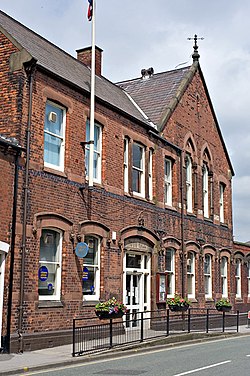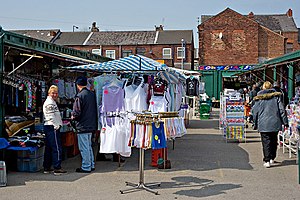Ashton-in-Makerfield: Difference between revisions
Created page with "{{Infobox town |name=Ashton-in-Makerfield |county=Lancashire |picture=Ashton-in-Makerfield Town Hall.jpg |picture caption=Ashton-in-Makerfield Town Hall |os grid ref=SJ57499..." |
|||
| Line 75: | Line 75: | ||
*{{Citation |last=James|first=Gary| title=The Official Manchester City Hall of Fame |publisher=Hamlyn |year=2005 |isbn=0-600-61282-1}} | *{{Citation |last=James|first=Gary| title=The Official Manchester City Hall of Fame |publisher=Hamlyn |year=2005 |isbn=0-600-61282-1}} | ||
{{refend}} | {{refend}} | ||
{{DEFAULTSORT:Ashton-In-Makerfield}} | {{DEFAULTSORT:Ashton-In-Makerfield}} | ||
Latest revision as of 21:17, 23 December 2016
| Ashton-in-Makerfield | |
| Lancashire | |
|---|---|
 Ashton-in-Makerfield Town Hall | |
| Location | |
| Grid reference: | SJ574992 |
| Location: | 53°29’13"N, 2°38’28"W |
| Data | |
| Population: | 28,762 (2011) |
| Post town: | Wigan |
| Postcode: | WN4 |
| Dialling code: | 01942 |
| Local Government | |
| Council: | Wigan |
| Parliamentary constituency: |
Makerfield |
Ashton-in-Makerfield is a town in southern Lancashire, standing four miles to the south of Wigan. In 2001 it had a population of 28,505, increasing to 28,762 at the 2011 Census.
Ashton was anciently a township in the parish of Winwick, and later 'Newton-in-Makerfield', the latter now known as Newton-le-Willows. With neighbouring Haydock, Ashton-in-Makerfield was a chapelry, but the two were split in 1845.
The place has long been a centre for the manufacture of locks and hinges, but also sits on the Lancashire Coalfield, and so was a coal mining district.
Name
The name 'Ashton' is from the Old English Æsctun, meaning 'Ash-tree farmstead', a common name. The name was recorded as Eston in 1212.
The suffix "in-Makerfield" is a later addition, which relates the name of the old district of Makerfield of which Ashton was a part; 'Makerfield' appears to derive from the Old Welsh for a wall or ruin and the Old English word feld, meaning "open land".[1]
History
Church history
St Thomas' Church on Warrington Road has ancient origins although the present building is barely over 120 years old. The graveyard is the resting place of many of the 189 victims of the Wood Pit explosion (at Haydock on Friday 7 June 1878), the worst coal-mining disaster in Lancashire at the time.
Hope Church on Heath Road was founded by Protestants from St Thomas' opposed to the High Church ideals brought in by a new Vicar in the 1880s. His introduction of Anglo-Catholic worship caused riots on Gerard Street and he was initially evicted from the town by a mob of miners. He returned backed by troops from Liverpool. Banned from worshipping in the form they had always done, many left and continued a simpler form of worship in a barn off Ashton Heath. Word of their plight reached a Miss Catherine Cave-Browne in London who sent money for a Protestant Mission to be built. The church was built with the official title of Cave-Browne Protestant Institute (Christchurch).
The Park Lane Chapel (see Unitarianism), Wigan Road, Bryn, dates back to 1697, although its congregation was founded in 1662. It is the oldest non-conformist chapel and congregation in the district. By the 19th century Park Lane was only one of nine non-conformist chapels in the area. There was a Baptist, Congregational church (Hilton St), Evangelical (Heath Road), Independent, Independent Methodist (Downall Green Road), Primitive Methodist, Welsh Wesleyan Methodist, and English Wesleyan Methodist chapel.
A Roman Catholic church, St Oswald and St Edmund Arrowsmith, was buit in 1935.
Coal mining and heavy industry
Ashton-in-Makerfield was part of the St Helens Area of the South Lancashire Coalfield. The St Helens Area lay to the South West of the Wigan area and occupied around 60 square miles, skirting Wigan, Warrington, Widnes and to within eight miles of Liverpool.
In 1867 there were 13 collieries in the district of Ashton-in-Makerfield. Others followed including Bryn Hall Colliery, owned by Edward Frederick Crippin, the Mains and Park Lane Collieries. Park Colliery and some of those open in 1867 (for example Garswood Hall) remained productive until the 1950s.[2]
A number of Ashton's coal miners made a significant impact on modern British history, including: Stephen Walsh MP; William Kenealy, VC Lance-Corporal in the 1st Lancashire Fusiliers; and Joe Gormley, President of the National Union of Mineworkers in the 1970s and 1980s.
In the late 19th century, the district was described by one observer as having "extensive collieries, cotton mills and potteries", and famed for the manufacture of "hinges, locks, files and nails".[3] Mills such as the Record Mill (Spinning), situated in York Road, and the Makerfield Mill (the 'Weaving Shed'), in Windsor Road, took over from home-working. Similarly, Thomas Crompton & Sons in Gerard Street, which would eventually employ around 1,200 workers, superseded the subcontracting system that sustained substantial numbers of locally based blacksmiths and other craftsmen.
As recently as the 1970s the district of Ashton-in-Makerfield had one of the highest proportions of derelict land, mainly in the form of spoil tips, left over from coal mining.[4] Major land reclamation schemes have since completely transformed the area.
The town today

A market is held on the market square off Garswood Street on Tuesdays and Saturdays.
Crompton's, the hinge and fasteners making factory in Ashton-in-Makerfield, has closed and is now demolished. A shopping centre called the Gerard Centre now stands in its place.
The Hingemaker's Arms public house, on Heath Road, is the only one in the world known to carry that name. It was run by the Corless family for decades until Walter Corless' retirement in 2006. The Hinge, as it is known by its clientele, is now owned and operated by a consortium of local businessmen.
The site now occupied by Byrchall and St Edmund Arrowsmith high schools was the location of a Second World War Prisoner-of-war camp, Camp 50.
Sport and leisure
Ashton has two semi-professional football clubs:
- Football:
- Ashton Athletic F.C.
- Ashton Town A.F.C
- Garswood United F.C.
Outside links
| ("Wikimedia Commons" has material about Ashton-in-Makerfield) |
References
- ↑ Mills, A.D. (2003), A Dictionary of British Place-Names: Ashton, Oxford: Oxford University Press, ISBN 0-19-852758-6, http://www.oxfordreference.com/views/ENTRY.html?subview=Main&entry=t40.e595&category=(subscription required)
- ↑ source: Coal Mining History Resource Centre
- ↑ Bartholomew, John (1887), Gazetteer of the British Isles, ISBN 0-00-448835-0, http://www.visionofbritain.org.uk/place/place_writing.jsp?p_id=245
- ↑ source: Longman Atlas of Modern British History (1978)
- James, Gary (2005), The Official Manchester City Hall of Fame, Hamlyn, ISBN 0-600-61282-1
